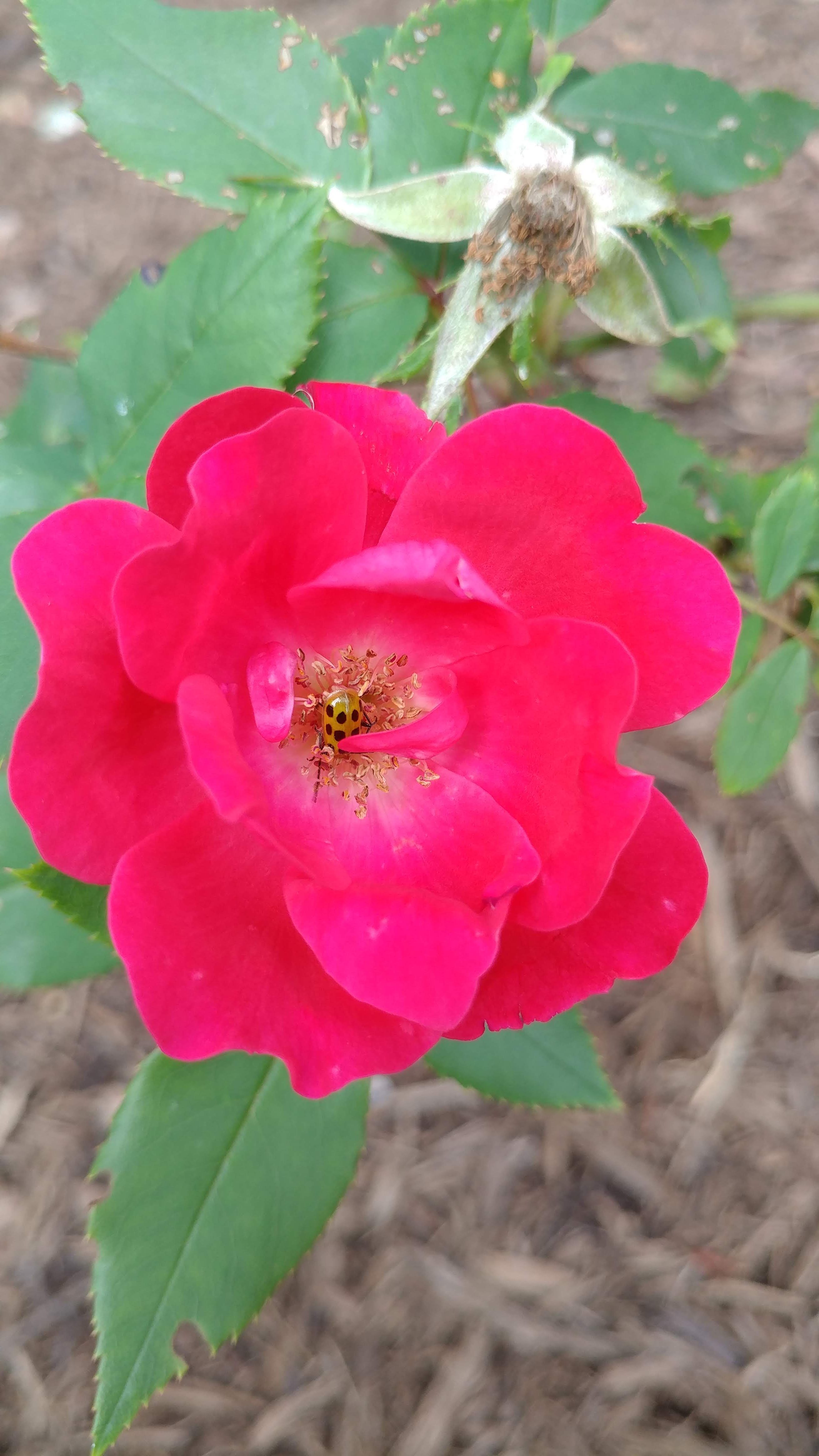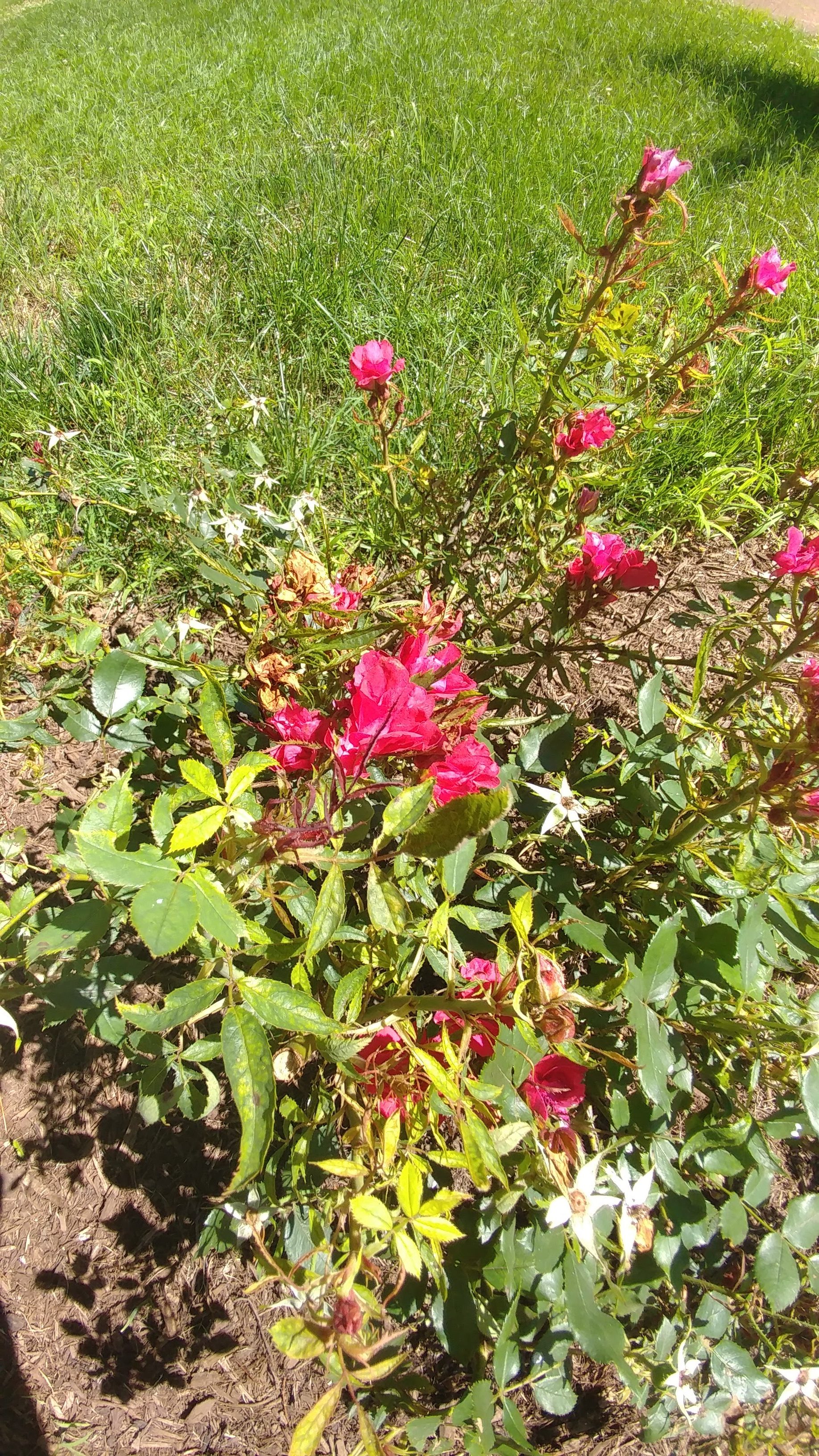
DISCLOSURE: THIS POST MAY CONTAIN AFFILIATE LINKS, MEANING I GET A COMMISSION IF YOU DECIDE TO MAKE A PURCHASE THROUGH MY LINKS, AT NO COST TO YOU. PLEASE READ MY DISCLOSURE FOR MORE INFO.
The writing on the wall
When we moved into our house in Bellevue three years ago, I noticed the rose bushes on the edge of our property could use a little TLC, and I have been trying to save them ever since. This included taking two out that had reached the end of their lives and replacing them with new ones. I wish I had done a little more extensive research before doing that because had I known about rose rosette disease, I could have saved some time and money. But, I just chalked it up to me being terrible with rose bushes, since they seem to be growing in leaps and bounds everywhere I look. I seem to have the worst luck with plants that are supposedly easy to take care of.
First, I noticed spots on new leaves, and looked that up. Some sort of insect, so I used some rose food specifically for roses that also took care of those pests. I started to see a little improvement, especially with the ones that I had planted. The other two, however, just never seemed to look like those full bushes that I see in landscaping everywhere. I mean, if Krystals and Burger Kings across Nashville could have such thriving knockout roses, why couldn’t I? People in my Middle Tennessee Plant Swap Facebook group were even talking about getting rid of them because they were JUST TOO BIG. Insert crying laughter emoji here. Then just crying emoji.
Every year I pruned away all the dead branches and fed with the Bonide Systemic Rose and Flower Care. It helped with the small holes I was seeing on the leaves, but overall, new growth was not looking good. This year, I pruned them all back hard in a last ditch effort. I even took some pictures after pruning because I was so sure I was going to have some miraculous growth that I could post about. It would be a before and after to rule them all! My pinterest would be blowing up after I shared my secrets about reviving a near death rose plant.
Oh, if only I had seen the writing on the wall sooner. Now I have a before and after. Just not the kind that people are usually looking for. I happened to google “new growth on rose bush” because I was curious if the super thorny and red stems, clusters of leaves, and quick to die flowers was normal. The first post that came up was about red leaves on rose bushes on gardeningknowhow.com and I quickly read through the whole thing since that was what I was seeing. Unfortunately, it was not good news.
Once the bush is infected with the Rose Rosette disease (virus), it is doomed. The bush and the immediate soil around it must be taken out and destroyed, tossed in the trash. It is a fatal infection with no known cure; and the sooner the bush is removed and destroyed, the better for the other rose bushes in your garden or rose bed.
Once I saw that, I went down a rabbit hole searching for more information about Rose Rosette disease. Just google “Rose Rosette disease” and you will find a plethora of pictures as well as articles from just about every master gardener, nursery, landscaper, agricultural extension center of universities, and major publication like USA Today, Southern Living, HGTV, and Chicago Tribune.
Rose Rosette Disease – What it is, what it looks like, what to do
What does it look like? Here are some tell-tale signs from Proven Winners among others:
- increased growth and/or rapid elongation of shoots
- new leaves and twigs have an abnormally bright, rich red color
- leaves may be distorted, curled or twisted
- an overabundance of foliage may be produced
- spiral pattern of cane growth
- canes produce excessive, red-tinged thorn growth
- atypical flower coloration, such as mottling
- deformed buds and flowers
As you can see from my pictures, they have just about every one of those symptoms. Don’t they look super deformed and bizarre? The flowers look like they have melted or something.
The virus is carried by eriophyid mites, and when they feed on the rose, they transmit the disease. Once that happens, the rose bush is pretty much a lost cause. So, all my efforts to save those roses were like bailing out a sinking ship with a paper cup. A couple posts out there can tell you some things you can do to save the bush if you catch Rose Rosette disease in its early stages. This involves pruning affected branches and using some combination of bleach to clean pruning shears after each cut, spraying with horticultural oil, blah blah blah. Those people only saw success half of the time. Seriously, just dig up the infected plant and cut your losses. Every other site comes to the same conclusion: dig up the infected plant, including all the roots because the mites find their way to the roots too. I can confirm this as I had a faceful of them while digging out the roots. After you take it out, throw it in the trash (NOT the compost). You want to do this as soon as possible before it starts to infect the plants around it because chances are if you planted one knockout rose bush, you probably planted a whole bunch of them all right next to each other.
So, what can you do to prevent this from happening in the first place? Well, you need to keep your rose plant healthy, well “fed”, and free of pests. Begin by buying healthy rose plants to start with. Make sure the leaves and roots look healthy, the plant doesn’t look stressed, and scan for pests to the best of your ability. Starting with a healthy plant in the first place can save you a lot of headaches down the road. Maybe the clearance rack at Lowe’s isn’t the best idea.
Once you have a healthy rose plant, how do you keep it healthy? When planting new rose plants, amend the hole with organic matter as well as a slow-release fertilizer. Espoma’s Rose Tone is highly recommended among rose growers. Fertilize monthly during the growing season with Espoma’s Rose Tone or Alaska Fish Fertilizer, also highly recommended. I know quite a few people who make their own alfalfa tea fertilizer, but Espoma also makes an alfalfa meal fertilizer if you don’t want to make your own.
Fungal diseases like black spot are fairly common threats to rose health, so preventing and addressing that is key to maintaining a healthy rose plant. You can help prevent black spot by improving the air circulation around roses and not overcrowding them. Avoid overhead watering, particularly at night. You can stop the infection from spreading by using neem oil, dormant spray oil, or copper fungicide and spraying the entire plant. Neem oil and dormant spray oil have the added benefits of managing a lot of common pests of roses like aphids, whiteflies, and mites.
If it gets rose rosette disease, though, there’s nothing you can do. Take those roses out. There are some posts out there that describe when and how you can replant roses in that same spot, but my thought is WHY?
I’m going to stop trying to make roses happen. They’re pretty. I get it. But to me, they are in no way remotely worth the effort they take. I planted some azaleas there and called it a day because one of the blessings of Rose Rosette disease is that it only affects roses. I contacted the Nashville Rose Society to get some confirmation about this, since there isn’t a lot of information out there about what you can plant in the place where the roses were. Here is what they said:
Yes, you can replant in those spots, including roses. Plants other than roses should not be affected. This is what the ARS Consulting Rosarian Manual says:
The causal agent of rose rosette disease is not soil-borne (it is actually air-borne), so it is possible to successfully plant healthy roses in beds where diseased plants have been removed; however, the pathogen may persist in old root pieces that remain in the soil from previous diseased roses. If plants regrow from these old root pieces, as multiflora rose is apt to do, they can serve as an infection source for healthy plants. Therefore, it is important to remove old plants thoroughly and ensure that infected plants are not allowed to regrow from old, infected root pieces.
It just doesn’t seem to be worth it. Rose rosette disease is just one of many diseases and pests that afflict roses, and they just seem so high maintenance for flowers that are only marginally more pretty than others.
Have you experienced Rose Rosette disease? What did you do? Do you share my thoughts on roses, or am I the only one?





I just discovered it and need to remove two huge plants. My entire front yard path are knock out roses and i’m Afraid soon they’ll All be infected.
As long as you remove the infected ones, the others might make it. Unfortunately, I planted new ones before removing the infected ones, so then the new ones got infected too. 🙁
I started seeing signs of the virus two years ago, didn’t think much of it at first. The second year more shoots became infected. We cut the knockouts way back and this year when they sprouted back, the whole plant was infected. They totally morphed into this strange bush. We cut them down and dug up the roots. Just now found out that they had rose rosette disease. Hated to lose them after having them for over 15 yrs.
Same thing for me! I thought cutting it back would fix the issue, but the whole thing came back even worse. Unfortunate that it can’t be cured!
I’ve recently started planting Rose’s in my garden which is also new…I just want to know how to detect rose rosette disease, or how to distinguish between new growth from the diseased growth? I’m in South Africa in Durban North.
New growth on roses is red as well, but the leaves will still have the same shape and spacing along the branches. The new leaves will look like all the other leaves, but have a reddish tinge, whereas with rose rosette, the new leaves will also look deformed or curled up. The leaves will be heavily concentrated at the top rather than maintaining the same spacing. Also, the stem will be thicker and excessively thorny. So, as long as the new leaves look normal in shape, it’s expected for the new growth to be red. Just be on the lookout for distorted leaves and excessive thorniness on the stem!
Great article. I have 150 rose bushes at my home. Last year I had one rose bush with RRD. I didn’t know and took it out as it started to deform. Now I have half of them with RRD and I cutting and pruning everyday to save other half. Really tragice. 😢
Peter Shah
petershah@msn.com